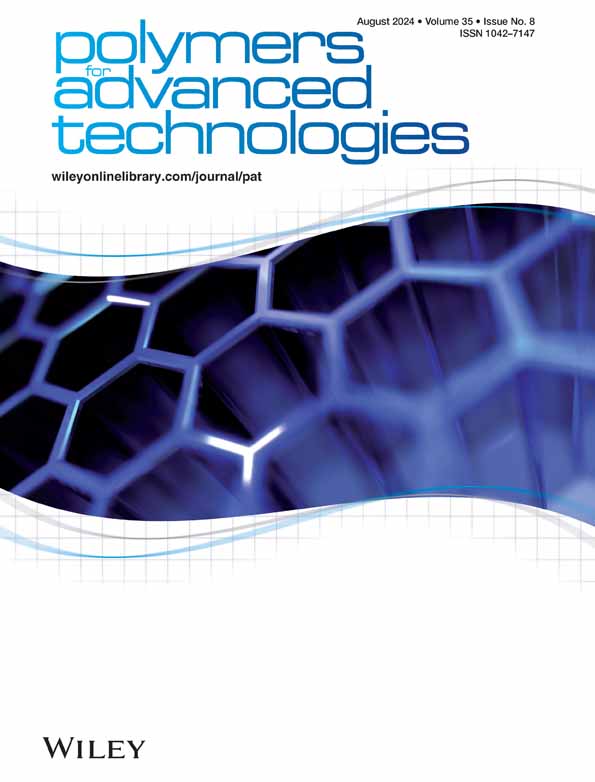Multifunctional skin dressings synthesized via one‐pot photopolymerization: Advancing wound healing and infection prevention strategies
IF 3.4
4区 工程技术
Q2 POLYMER SCIENCE
引用次数: 0
Abstract
In the field of wound healing treatment, the development of new materials is essential to cover multiple functions, such as acceleration of the healing process, prevention of infection and response to stimuli, especially if they present lower costs or are easier to manufacture. These properties are of great importance to prompt skin cicatrization. In this work, new multifunctional skin dressings for wound healing and infection prevention are developed based on new hydrogel materials. The dressings are produced via a straightforward and environmentally friendly one‐pot photopolymerization manufacturing process utilizing vitamin B2 aqueous solutions as sensitizer, and energy‐efficient blue light sources. These dressings exhibit a high swelling capacity, pH and temperature responsiveness, biocompatibility, antimicrobial activity in the absence of conventional antibiotics, and are capable of promoting wound healing. The formulation is based on the combination of three monomers: 2‐((methacryloyloxy)ethyl)trimethylammonium chloride, methacrylic acid and N‐vinyl caprolactam. Collagen, hyaluronic acid, and essential oil of hop are added to enhance antimicrobial properties and stimulate regenerative cellular processes.通过单锅光聚合合成的多功能皮肤敷料:推进伤口愈合和感染预防策略
在伤口愈合治疗领域,新材料的开发对于涵盖多种功能至关重要,如加速愈合过程、预防感染和对刺激做出反应,尤其是在成本较低或易于制造的情况下。这些特性对于促进皮肤皲裂非常重要。这项研究以新型水凝胶材料为基础,开发了用于伤口愈合和预防感染的新型多功能皮肤敷料。这种敷料是利用维生素 B2 水溶液作为敏化剂和节能蓝光光源,通过简单、环保的单锅光聚合生产工艺制成的。这些敷料具有高膨胀能力、pH 值和温度响应性、生物相容性、在不使用传统抗生素的情况下的抗菌活性,并能促进伤口愈合。该配方基于三种单体的组合:2-((甲基丙烯酰氧基)乙基)三甲基氯化铵、甲基丙烯酸和 N-乙烯基己内酰胺。此外,还添加了胶原蛋白、透明质酸和啤酒花精油,以增强抗菌性能并刺激细胞再生过程。体内实验表明,与含有天然产品的敷料相比,纯敷料在促进胶原蛋白和成纤维细胞再生以及加速糜烂方面更胜一筹。嵌入啤酒花的敷料还具有抗菌特性。本文介绍了这些新型高效伤口敷料的制备和测试方法。这项研究的独特之处在于将环保生产技术与创新材料配方相结合,从而生产出既经济又实用的优质伤口敷料。通过在不使用传统抗生素的情况下提高伤口愈合和预防感染的能力,这项研究在可持续和有效的伤口护理管理方面取得了重大进展。
本文章由计算机程序翻译,如有差异,请以英文原文为准。
求助全文
约1分钟内获得全文
求助全文
来源期刊

Polymers for Advanced Technologies
工程技术-高分子科学
CiteScore
6.20
自引率
5.90%
发文量
337
审稿时长
2.1 months
期刊介绍:
Polymers for Advanced Technologies is published in response to recent significant changes in the patterns of materials research and development. Worldwide attention has been focused on the critical importance of materials in the creation of new devices and systems. It is now recognized that materials are often the limiting factor in bringing a new technical concept to fruition and that polymers are often the materials of choice in these demanding applications. A significant portion of the polymer research ongoing in the world is directly or indirectly related to the solution of complex, interdisciplinary problems whose successful resolution is necessary for achievement of broad system objectives.
Polymers for Advanced Technologies is focused to the interest of scientists and engineers from academia and industry who are participating in these new areas of polymer research and development. It is the intent of this journal to impact the polymer related advanced technologies to meet the challenge of the twenty-first century.
Polymers for Advanced Technologies aims at encouraging innovation, invention, imagination and creativity by providing a broad interdisciplinary platform for the presentation of new research and development concepts, theories and results which reflect the changing image and pace of modern polymer science and technology.
Polymers for Advanced Technologies aims at becoming the central organ of the new multi-disciplinary polymer oriented materials science of the highest scientific standards. It will publish original research papers on finished studies; communications limited to five typewritten pages plus three illustrations, containing experimental details; review articles of up to 40 pages; letters to the editor and book reviews. Review articles will normally be published by invitation. The Editor-in-Chief welcomes suggestions for reviews.
 求助内容:
求助内容: 应助结果提醒方式:
应助结果提醒方式:


